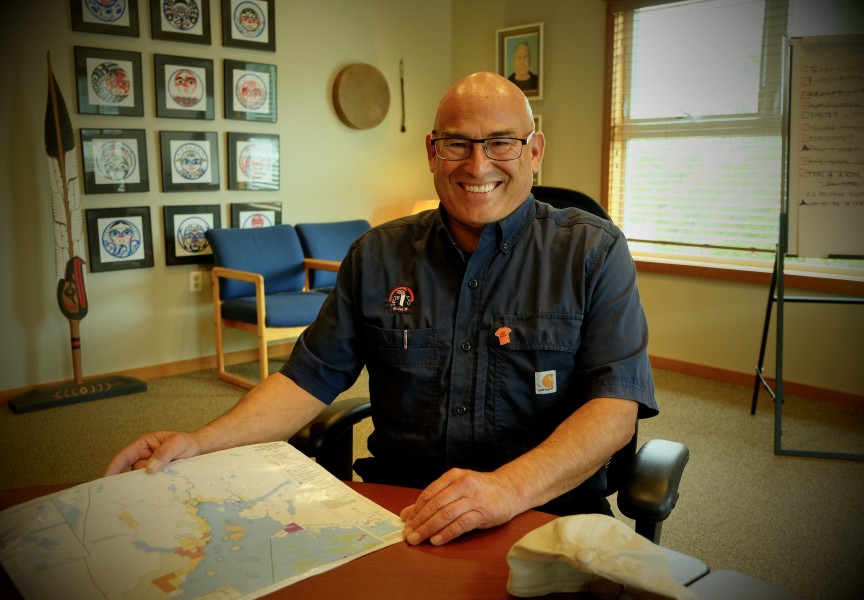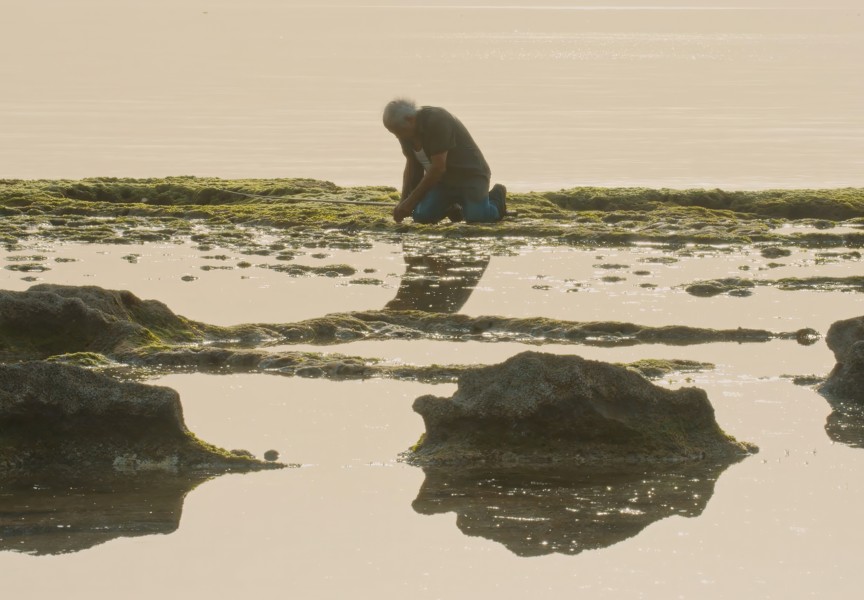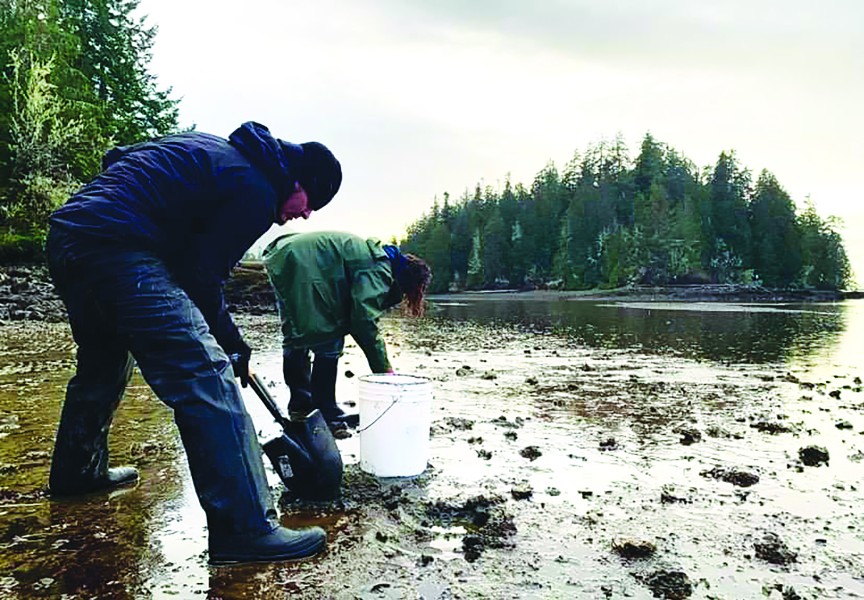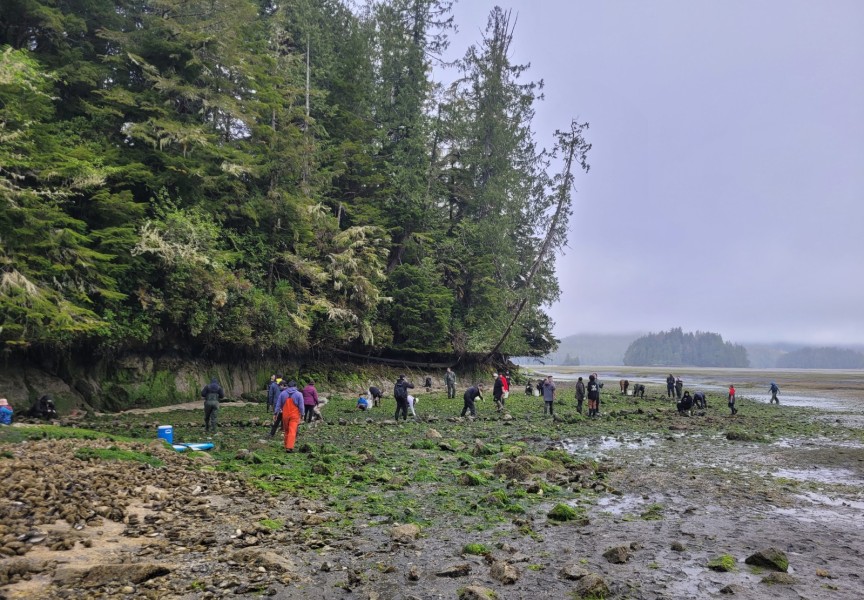This is article is part of a series of stories on Nuu-chah-nulth clam gardens.
From the captain’s seat of his fishing boat called ‘La Fortune’, Tla-o-qui-aht First Nation (TFN) fisherman Leo Jon Manson popped the lid off the proverbial can of worms labelled ‘float homes’.
Float homes are encroaching cultural and harvesting sites in Tla-o-qui-aht territory, says Manson. One spot in particular, Lemmens Inlet, a protected body of water located just north of Tofino that cuts into Meares Island, has succumbed to the region’s “laidback” regulations on float homes.
“We still have some spots in our territory, but we have to travel farther away from Opitsaht or Načiks (Tofino). We have to go farther back in the inlets. Our local grounds are gone, pretty much,” Manson said.
“All of Lemmens… every beach is taken over by float houses. All their sewer goes right on the beach, and I wouldn’t be able to feed anybody that stuff,” he said.
Margaret Titian, Manson’s wife, chimed in.
“It’s just completely infested back there. They’re everywhere. In every nook and cranny. We can’t go duck hunting in a lot of the areas we used to. We can’t go clam digging in some beaches because I don’t want poopy water clams,” she said.
Manson’s ancestors have been fishing and harvesting shellfish for millennia. His late father Leo taught him the livelihood and now his 20-year-old son Darren is out on the water with his own fishing boat; often their boats are beside each other and they’re fishing at the same time. If Darren starts his own family, he’ll teach his kids how to fish too.
“When I was younger, it was all Lemmens Inlet. That was our garden,” recalls Manson.
He says about a dozen float homes are popping up each year because “it’s cheaper to live in our cultural grounds than it is in the District of Tofino or Ucluelet.”
“But we’re paying the price culturally and environmentally,” said Manson.
Titian pointed out that they can’t harvest around local islands off Tofino yet either.
“There’s a lot of build-up,” she said.
Tofino was discharging raw sewage into the ocean up until September 2024 when its first-ever wastewater treatment plant became operational.
“I don’t think it will be clean for a few years, that whole area,” Manson adds.
Clam season is generally December, January and sometimes November.
Titian and Manson have so many photos and videos of their family out on rainy beaches, digging up clams, they could make a movie.
“We take all our kids out,” said Titian as she showed a video of her youngest daughter Marion out behind Meares Island, wearing a headlamp and full rain gear, giggling as she rakes back clams from her brothers’ stash.
“The little ones, when they were really little and they couldn’t use the rake to dig, we would point out the clams and they would grab it. That was their excitement and helping,” she said.
They told the Ha-Shilth-Sa they often go out at night during the big winter tides because that gives them more time to dig.
“We make it a challenge to see who would fill up the bucket the fastest,” Darren said. “Sometimes we eat them while we are picking them out of the ground. We pop them open with one of the propane lights and eat them right on beach.”
To detect the freshness of a clam, Titian says you put it up to your lips.
“If your lips go numb or has any sensation that is weird, it’s no good,” she said.
She showed another video of Marion throwing back a clam that was too small and explained that if a clam is smaller than the first bone off your thumb to your knuckle, it’s too small to harvest and should be pushed back into the sand.
Coastwide restrictions from Fisheries and Oceans Canada (DFO) states that Manila Clams or Littleneck Clams smaller than 35 mm and Butter Clams smaller than 55 mm are not to be harvested.
Manson shared that elders love Butter Clams the most, and co-incidentally these are the most sensitive of the marine bivalve mollusks found along the Pacific coast. In other words, Butters store marine toxins longer than other clams.
“I wish we had our territory back. Lemmens is real productive for seafood; for shellfish, crab, duck hunting,” Manson said. “We have dog salmon creeks back there, but (the float homes) all tapped into our creeks. Every rule has been broken in our ha-houlthee.”
DFO has posted sanitary contamination closures for several areas within Lemmens Inlet due to “floating living accommodation”. Butter Clams are listed as unsafe to harvest.
Float homes ‘likely in trespass’
Data from a 2024 float home survey launched by Tla-o-qui-aht Tribal Parks in partnership with Redd Fish Restoration Society revealed 44 float homes in TFN tradition waters with 39 of those float homes in Lemmens Inlet.
Reddfish plotted the coordinates of each float home and liveaboard on a series of maps and overlaid them on shorebird habitat, eelgrass and clam bed maps to support the development of a float home policy.
Tla-o-qui-aht Tribal Parks held a Float Home Symposium in April 2024 to encourage float home dwellers to sign a protocol agreement that says they will comply with environmental standards – and that they would move to a different location if their float home impacts a sensitive ecological area.
Twenty-eight float home dwellers showed up for the April symposium and 14 have signed the protocol agreement to date, according to Tribal Parks liaison Julian Hockin-Grant.
In a written statement, the B.C. Ministry of Water, Land and Resource Stewardship said there are a number of tenures for aquaculture purposes in Lemmens Inlet which fall under Water, Land and Resource Stewardship jurisdiction, but no tenures for float homes have been issued.
The use and occupation of Crown land in B.C., including aquatic foreshore for float homes, requires authorization under the Land Act, which is administered by the Ministry of Water, Land and Resource Stewardship.
“The province has a legal duty to consult First Nations when making decisions to issue Land Act tenures. The Ministry also considers potential impacts to cumulative effects in the decision-making process, and whether the environment can sustain additional float homes. As there are no tenured float homes in Lemmens Inlet, this process has not been completed,” the ministry told the Ha-Shilth-Sa in an email.
“If there are float homes in Lemmens Inlet, they are likely in trespass and their investigation would be the responsibility of the Natural Resource Officer Service in the Ministry of Forests,” the ministry’s email continued.
Suspected occupation of Crown land in trespass, or illegal dumping or pollution, can be notified to the Report all Poachers and Polluters program (RAPP) by reporting online: Report All Poachers and Polluters (RAPP) – Environmental Protection & Sustainability Forms or by phoning 1-877-952-RAPP.
Manson has raised the issue at TFN band and council meetings. He wants to see the float homes moved to one spot and not spread out within their traditional harvesting grounds.
This story was made possible in part by an award from the Institute for Journalism and Natural Resources and the Gordon and Betty Moore Foundation.











